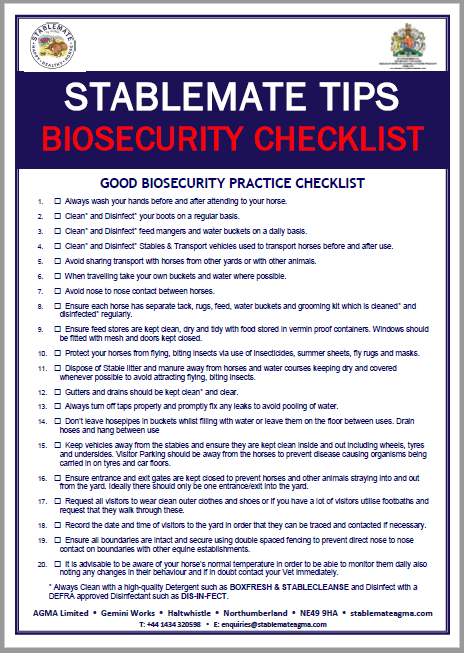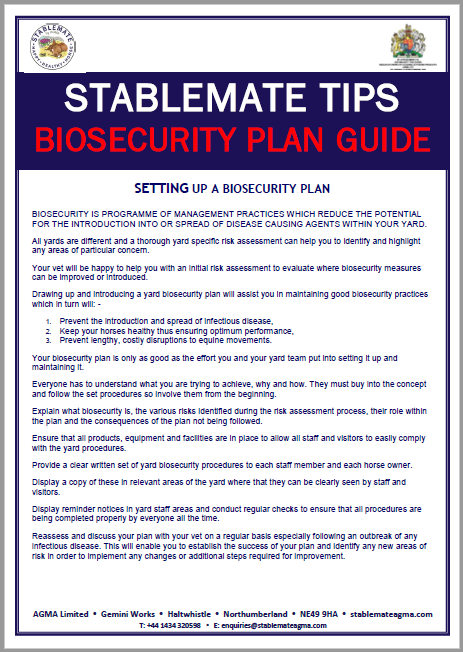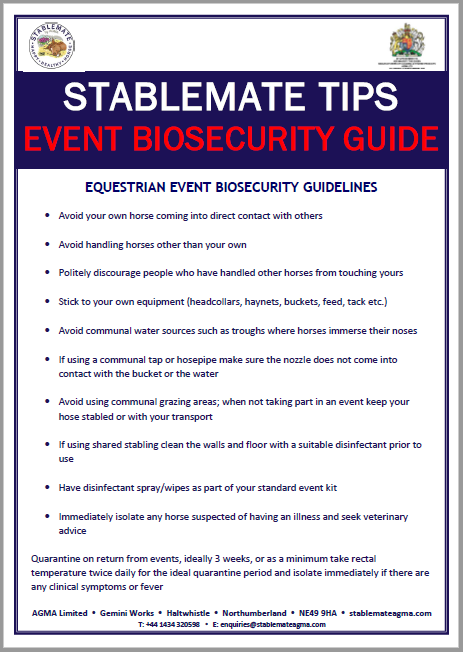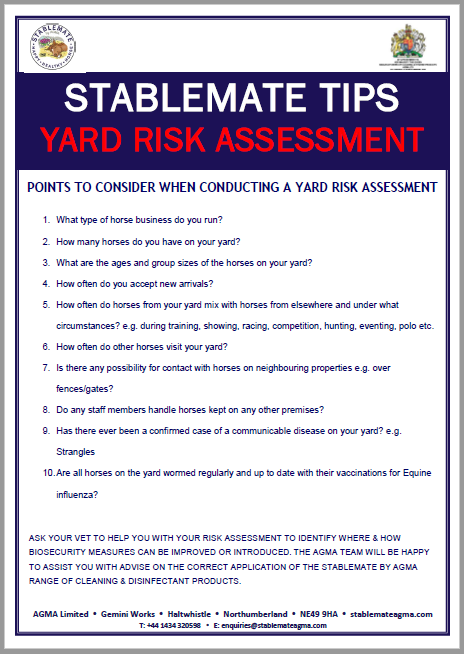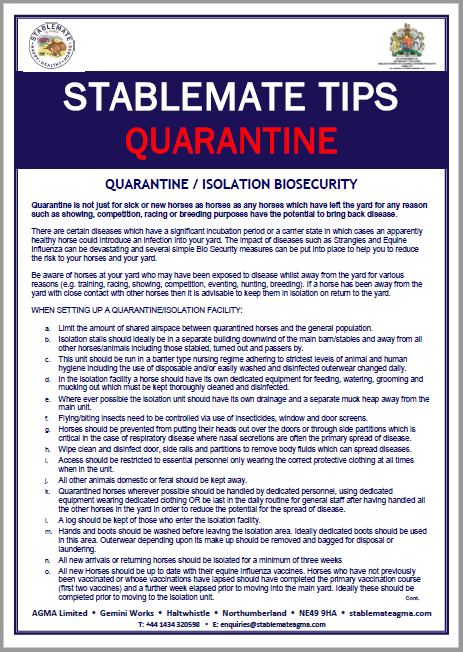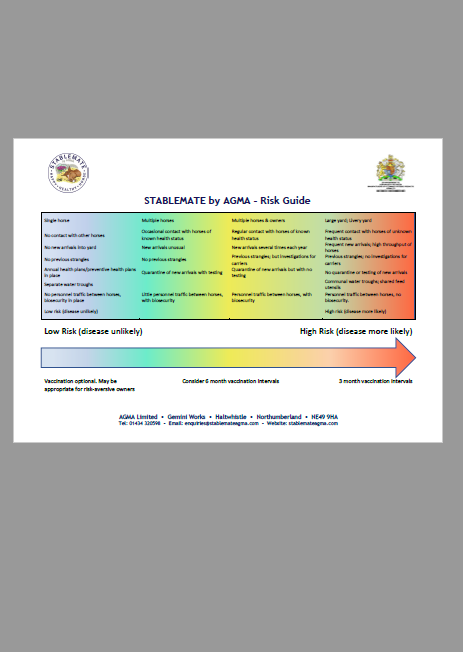Stablemate by AGMA
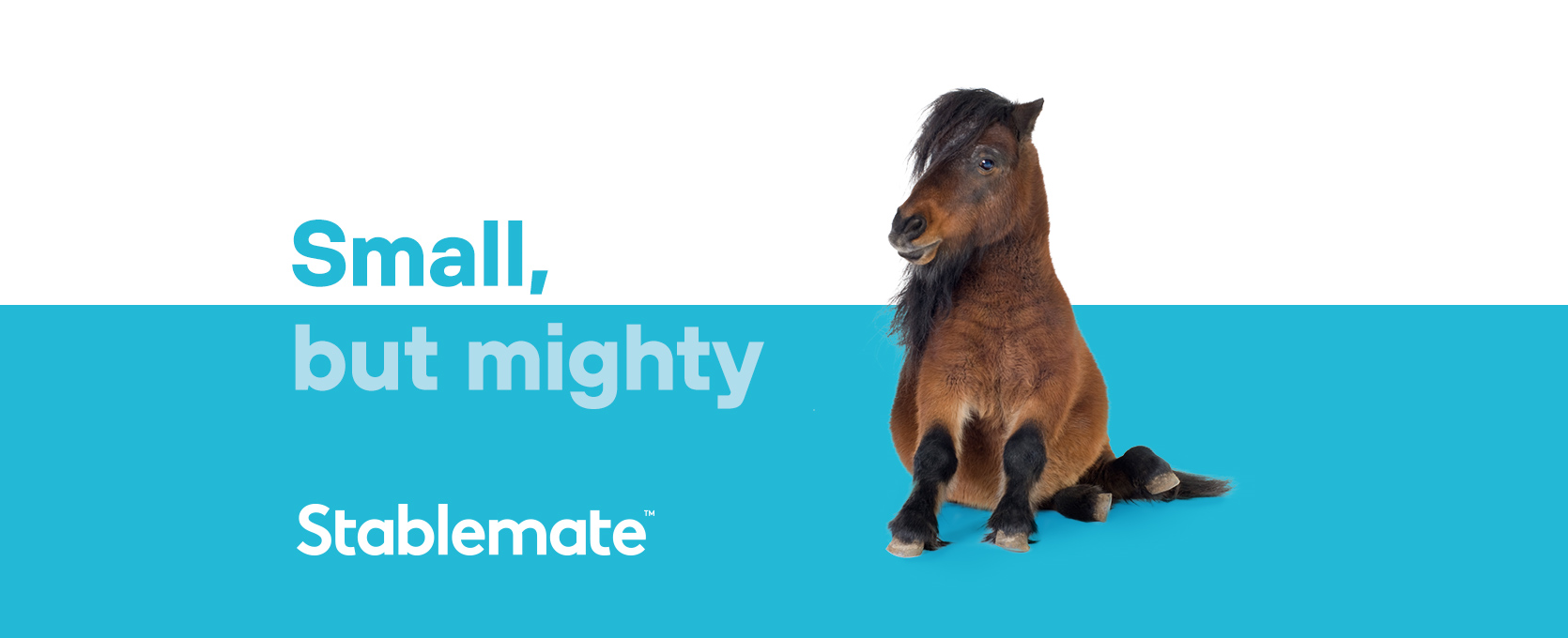
AGMA Limited, by Appointment to Her Majesty the Queen, Manufacturers of Cleaning and Hygiene
Products, has been developing, formulating and manufacturing speciality chemical products in Northumberland for over 52 years. The company specialises in the formulation of cleaning and biocidal solutions for a broad range of professional uses including the NHS.
Preventing the spread of disease is every horseman’s responsibility. Infection control or biosecurity (referring to procedures used to prevent the introduction and spread of disease-causing organisms) may only become important to them during or after an outbreak. Very often it is we humans who inadvertently carry these pathogens from place to place on our hands, shoes, clothes, equipment, and vehicles.
Vaccination, defined procedures for new arrivals or returning horses, and routine environmental cleaning and disinfection are the horseman’s insurance policy. Most of it is easy to carry out, inexpensive and common sense. Designated tack and rugs, regular cleaning and disinfection of surfaces and equipment, plus hand hygiene, is a good starting point. The most common way germs are spread is via our hands, so handwashing is very important in helping to reduce the spread of infections.
In order to prevent the spread of infectious diseases in horses, we must ensure adequate vaccination and employ routine, standard cleaning and disinfection procedures. There are many equine vaccines commercially available, but none can be guaranteed to be 100% effective – as we saw with the equine influenza outbreak. Vaccines are not currently commercially available for a number of major disease-causing organisms, making well-planned, well-executed cleaning and disinfection regimes, using good quality, independently tested and approved products, a must!
Many peer-reviewed studies have demonstrated that the environment plays a role in the transmission of infections. Environmental surfaces and equipment are potential sources for pathogens, increasing the risk of transmission between animals either through their direct contact with contaminated surfaces, or by contaminating the hands of their handlers, who then transfer these pathogens to other surfaces and animals.
This type of evidence supports the need to improve cleaning and disinfection of surfaces and equine equipment. Unseen fungal spores can seriously affect the respiratory system of a horse and have an impact upon its performance. This should be seriously considered when/if competing with your horse.
Not only do they result in direct respiratory effects, but they can also lead to recurring bouts of secondary infections due to associated immune suppression. Unless steps are taken to remove this unseen pathogen from the stable environment, achieving consistency of equine performance is going to be extremely difficult.
Selecting the correct cleaning and disinfectant products is essential for effective disinfection, in combination with correct application, the training of those who apply them, and adherence to the manufacturer’s instructions for use. This combination of product and good practice results in effective surface disinfection, reducing the risk and spread of diseases.
The general cleanliness of a barn or stable is paramount as the survival time of a microorganism outside the host body is increased by the presence of organic soiling (hay, manure etc). Therefore, the most effective way to keep disease from spreading throughout a yard is by keeping it clean and having a regular disinfection programme.
Cleaning is also essential prior to the application of the disinfectant as disinfectants are deactivated by organic materials. The more organic material such as dirt or manure that is present, the less effective the disinfectants are going to be and the more you customers are going to have to use detergent and elbow grease. This pre-cleansing step is a crucial part of the disinfection process, as simply spraying a dirty wall, floor, or piece of equipment with disinfectant won’t be effective at killing pathogens. Detergent plus hot water is extremely useful for effective pre-cleaning, getting
into the corners, cracks and crevices where pathogens are likely to exist. Hot water under pressure cleans by flushing and by hydraulic impact; it dissolves inorganic salts, emulsifies fats and washes away organic debris.
When choosing the right product, customers should always be advised to use a DEFRA approved disinfectant, at the manufacturer’s specified concentration and contact time for routine disinfection purposes, or at the DEFRA approved concentration for specific statutory disease orders notices as specified.
When choosing cleaning and disinfectant products, horse owners should consider the overall cost, not merely the price of the product. They should factor in the cost of labour to set up and use the product, plus any equipment required, and compare that to the cost of non-compliance, increased infections, and potential shutdown.
Strangles can have the most devastating effects on horse welfare as well as causing severe disruption, with the subsequent halting of animal movement for several weeks and the associated financial implications of lock down.
Disinfection, whilst important on a routine basis, becomes paramount when dealing with an infectious horse. For routine disinfection, horse owners will need to address a variety of organisms with a disinfectant which possesses a broad spectrum of anti-microbial activity against bacteria, viruses, fungi and spores.
The easier and safer a product is to use, the more likely we are to use it correctly and effectively. Look to stock cleaning and disinfectant products available in convenient, easy-to-use formats, such as trigger sprays containing ready-to-use solutions, liquid concentrates in accurate dosing bottles and tablet products – both of which simplify dosing.
Better management of the stable environment by regular cleaning and disinfection, dust-free bedding and adequate forage treatment can make a significant, long-term difference to a horse’s health and performance.
It cannot be overstated that vaccination and environmental hygiene are two critical components in a coordinated approach to infection control and disease prevention. Regular environmental surface cleaning and disinfection reduces pathogens in the environment and helps prevent their spread.
Other vital components include: a focus on hand hygiene; the use of contact precautions; staff education/ongoing training; and the implementation of quarantine procedures for new or returning horses. Whilst disinfection is effective at controlling the spread of disease, it cannot eliminate infections if carrier animals are continually introduced to susceptible populations. As such, it is also important to control movement into and out of a yard. All of these steps are critical and work together to help keep us and our animals safe.
Clean
1. Clear the stable, disposing of any manure, feed, and debris.
2. Brush, scrape and clean all surfaces in buildings and equipment, removing as much organic matter as possible.
3. Thoroughly clean all surfaces by scrubbing and spray-washing with a good quality detergent.
Rinse
1. After cleaning, rinse carefully from the top downward, making sure that all traces of the detergent are rinsed away.
2. Remove excess water and allow the surface to dry, as drying ensures that the cleaning agent and water will not dilute the disinfectant.
Disinfect
1. Once the surfaces that you plan to disinfect are clean and dry, make up a solution of your chosen disinfectant according to the manufacturer’s instructions.
2. Apply the disinfectant solution and allow it to dry. Do not rinse it off! Allowing the disinfectant to dry maximises the contact time of the biocide with the pathogens for an effective kill.
3. Feed and water buckets, drinkers and any equipment which comes into intimate contact with the horse should be rinsed with clean potable water after allowing the appropriate dwell time for the disinfectant. The walls, ceilings and floors of stables need to be physically cleaned and disinfected on a regular basis to prevent the build-up of pathogens in the indoor environment. Non-porous, smooth surfaces are the most easily cleaned and disinfected, but the construction and design of many barns and stables use porous surfaces. As these can harbour pathogens, consideration should be given to applying an appropriate coating to seal these, having thoroughly cleaned and disinfected them before sealing. This will provide a smooth, waterproof surface, which can then be more easily cleaned and disinfected.
DO NOT forget about shovels, forks, or grooming equipment. This type of equipment can be soaked for several minutes to loosen any organic material, then scrubbed clean, rinsed, dried, sprayed with disinfectant, and allowed to dry.



